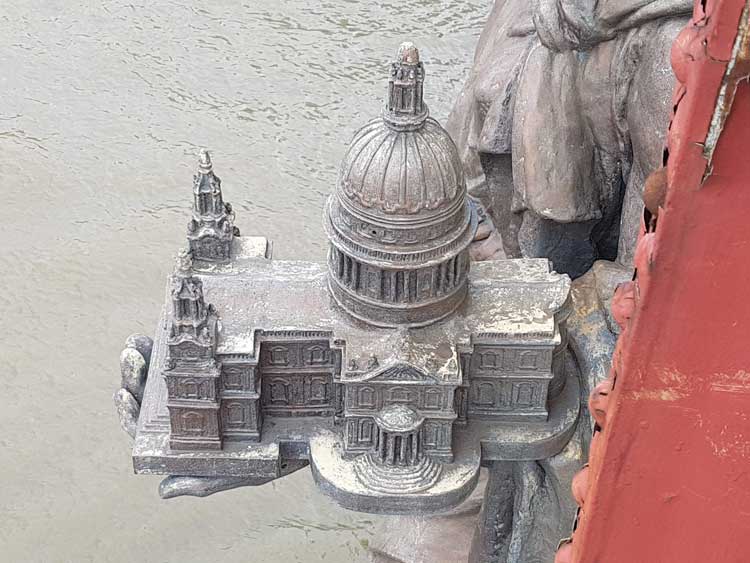
Have you ever paid a visit to St Paul's Cathedral on Vauxhall Bridge?
Did you even know that you can visit St Paul's Cathedral on Vauxhall Bridge?
If your answer to either, or both, of these questions was, "no", then don't worry, you're most certainly not alone.
In fact, I would hazard a guess that the majority of the people who cross back and forth over the bridge, day in and day out, have never noticed its best kept secret.
To see it, you have to make your way along the upriver side of the bridge, pause by the second iron column, lean over the parapet, and look at the hands of the statue that represents architecture.
There, in the palm of her hand, you will spot a miniature version of St Paul's Cathedral.
It's incredibly detailed, suitably aged by over a hundred years exposure to the elements; and it is, without doubt, one of the smallest, if not the smallest, cathedrals in England, if not in the whole wide world.
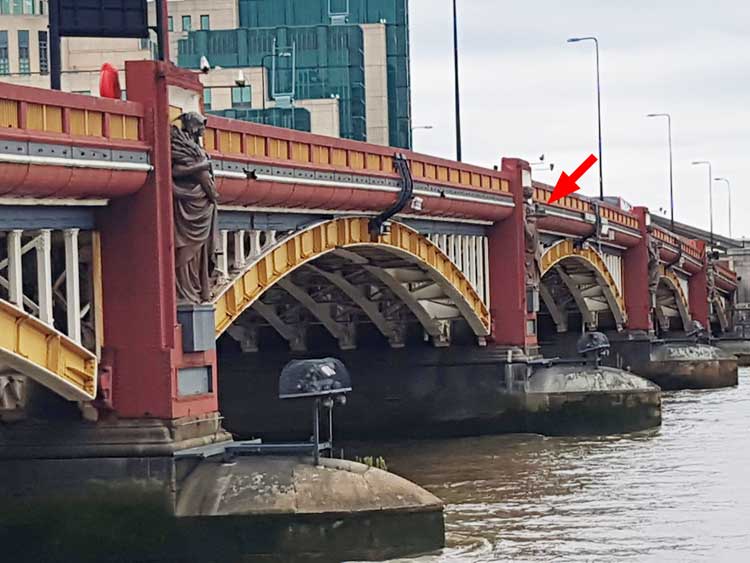
The Statue Representing Architecture
The Red Arrow Points To The Miniature St Paul's Cathedral.
This is, in fact, the second Vauxhall Bridge to span the Thames at this site.
The first bridge had the distinction of being the first iron bridge ever built over the River Thames, albeit the piers on which the bridge stood were of stone.
It was constructed under the powers of an Act of Parliament, passed in 1809, which authorised:- "the building of a bridge across the Thames from or near Vauxhall Turnpike to the opposite shore and the making of convenient roads thereto."
The first stone of the new bridge was laid on Saturday, 11th May, 1811, by Lord Dundas (1741 - 1820), who stood in for His Royal Highness, the Prince Regent.
The bridge was initially going to be called "Regent's Bridge", but, by the time work on its construction got underway, in September, 1812, the decision had been taken to name it "Vauxhall Bridge."
The building of the bridge wasn't without mishap, as can be gleaned from the following report, which appeared in The Windsor and Eton Express on Sunday, 8th August, 1813:-
"On Friday evening, about four o'clock, the pier erected on Millbank, for the purpose of landing stones of great weight, to build Vauxhall Bridge, suddenly gave way, in consequence of the workmen overloading it.
Three men were on it when it first began to fall, and they could not escape before the whole building was precipitated into the river.
Providentially it was low tide.
There were many persons walking about, who, upon hearing the tremendous crush, repaired to the spot, when, to their great astonishment, they saw the three persons emerging from their perilous situations unhurt with the exception of few slight contusions."
The bridge was opened to foot passengers in June 1816, and to carriages in July 1816.
For the next sixty three years, Vauxhall Bridge was a toll bridge run by a private company.
The premise behind the enterprise was that, with London expanding ever outwards, it wouldn't be long before Vauxhall was developed into one of the prosperous suburbs of the Metropolis.
In consequence of the expected prosperity, the company set the tolls relatively high, charging a penny for pedestrians to cross the new bridge and up to 2 shillings and 6 pence for vehicular traffic, such as horse-drawn coaches.
Unfortunately, things didn't go quite as planned.
In 1815, the Doulton and Woods factory was opened at Vauxhall, and, to accommodate the workers, working-class tenements began to appear, rather than the grand houses for the prosperous classes that the company had anticipated.
Then, in 1816, Millbank Prison was built on the north bank of the River, the presence of which was, to say the least, not exactly conducive to the prosperous classes wanting to settle on that side of the River.
However, following a decidedly rickety first few years, income from tolls did begin to increase, and, by the 1850's, the company was doing very well indeed.
Then, in 1877 the Metropolis Toll Bridges Act was passed, which allowed for the Metropolitan Board of Works to purchase all the London bridges that were situated between Hammersmith Bridge and Waterloo Bridge and remove the tolls.
In 1879, Vauxhall bridge was purchased by the Metropolitan Board of Works for the princely sum of £235,000, and the tolls came to an end.
By this time, there were complaints that the bridge's arches were impeding the progress of traffic on the River Thames, so the new owners sought, and were granted, permission to remove the two central piers, converting three of its nine arches into one.
On the foundations being exposed, however, they were found to be in a precarious condition, and it was decided that the best course of action would be to rebuild the bridge entirely.
Obviously, the closure of such an important river crossing could have led to chaos in the area, so whilst the old bridge was being demolished, a temporary bridge was constructed in front of the nearby Tate Gallery.
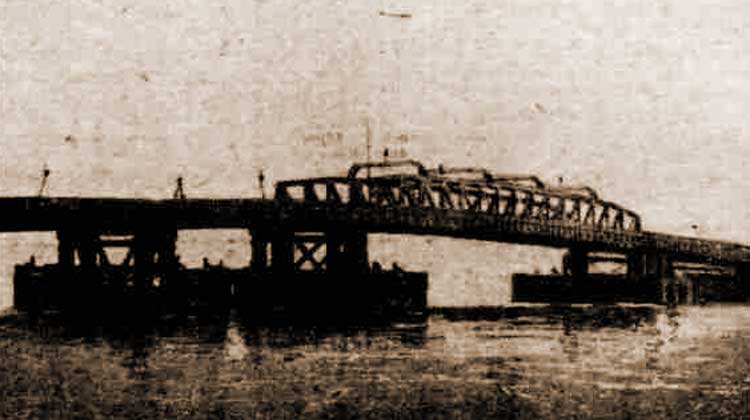
The Temporary Vauxhall bridge
From The London Daily News 22nd January, 1907
Copyright. The British Library Board.
The go-ahead for the new bridge was given in 1896, and work on the demolition of the old and the construction of the new bridge, designed by Sir Alexander Binnie (1839 - 1917), was commenced in September, 1898,
Although it had initially been estimated that the construction would be finished by 1900, the project was beset by numerous problems, and the new bridge wasn't fully completed until 1906.
On Saturday, 21st April, 1906, as construction neared completion The Morning Post gave an account of the rebuilding of Vauxhall Bridge:-
"The necessary powers to expend £484,000 for this purpose [that of building a new bridge] were obtained by the County Council in 1895, and it was anticipated that the new bridge would be finished by the end of 1900, but from one cause and another delays have arisen.
The new structure is a five-span bridge, as against the seven spans at Westminster, and is square to the river and nearly in a straight line with Vauxhall Bridge-road.
Its total length is 759 ft., with a waterway of 699 ft, 4in, two central piers are each 15ft, 6in, wide, and the two intermediate piers are 14ft. 6in. wide.
Down the centre runs a double line of tramways connecting the newly-electrified Vauxhall Bridge-road tramways, by way of Vauxhall Station, with the County Council system south of the Thames and giving direct communication from Victoria Station to all the places served by the tramways now running from Westminster, Waterloo, and Blackfriars Bridges.
The bridge is built with massive blocks of granite and masonry, and has pedestals at the four corners intended to carry groups of statuary pylons.
The parapets of the abutments are formed of granite walls 12ft. high, pierced by arches across which are built open balustrades, the superstructure being entirely of steel and iron."
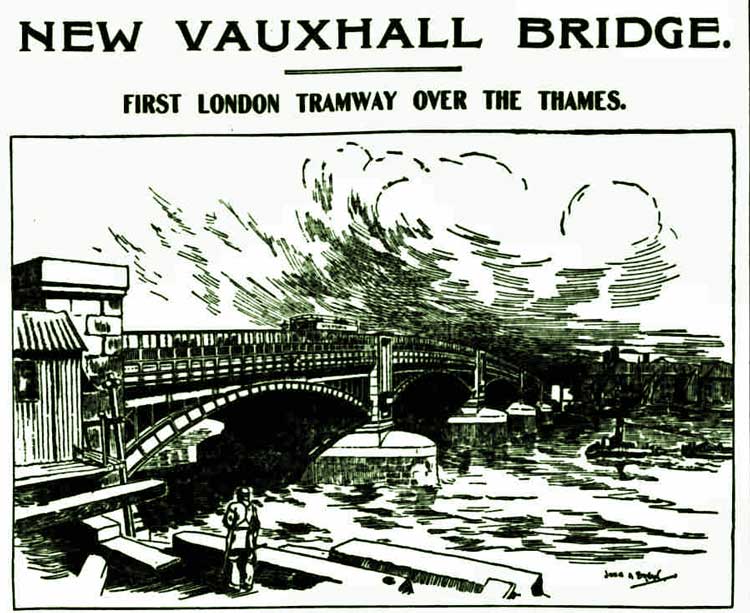
A Sketch Of The New Vauxhall Bridge.
From Daily Telegraph and Courier (London) Thursday, 24th May, 1906
Copyright. The British Library Board.
As the opening day for the new bridge drew nigh, The Exeter and Plymouth Gazette gave details of some of the problems that had faced the builders of the new bridge, in its edition of Friday, 25th May, 1906:-
"The opening of Vauxhall Bridge on Saturday signalises the completion of an undertaking which has been marked by many feats of engineering skill.
In carrying out their work, those engaged in the construction of the bridge have been not a little hampered by restrictions.
Under compulsion not to obstruct the waterway, it became necessary to build the great spans of the bridge away from their ultimate destination.
The engineers solved the difficulty by constructing the spans upon a huge pontoon, moored in the stream at a point a little below the bridge itself, which was tugged up stream at night time and allowed to drop into position with the ebbing of the tide."
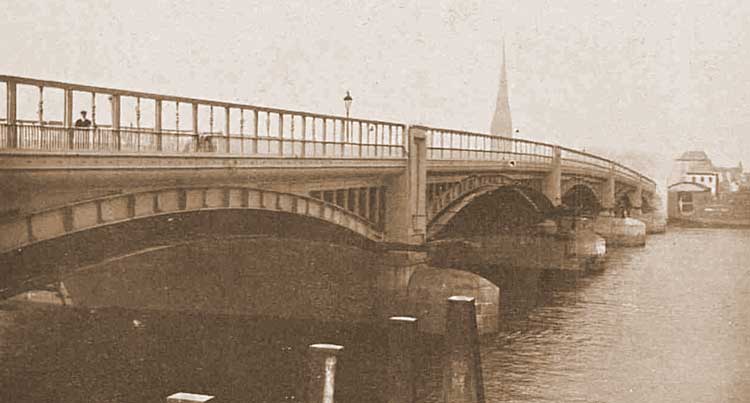
The New Vauxhall Bridge.
Notice The Vacant Niches For The Statues.
From The Sphere, Saturday, 26th May, 1906
Copyright. Mary Evans Picture Library.
On Saturday, 26th May, 1906, Mr Evan Spicer (1849 - 1947), Chairman of the London County Council, formerly declared the bridge open to the public.
The Daily Telegraph and Courier (London) reported on some of his remarks in his opening speech in its edition of Monday, 28th May, 1906:-
"..The Vauxhall bridge marked a very important development in regard to transit, inasmuch as it bore the first tramway that had ever crossed a London bridge. (Cheers.)
At present, horse power would have to be employed for the trams, but it was sincerely to be hoped that the House of Lords would soon pass a bill admitting of the use of electricity.
The chairman then formally declared the bridge open to the public for ever. (Cheers.)"
The speeches over, the Countess of Carrington was then called upon to throw down the crimson cord, that barred the approach to the bridge from the north side of the river, and the new Vauxhall Bridge was open.
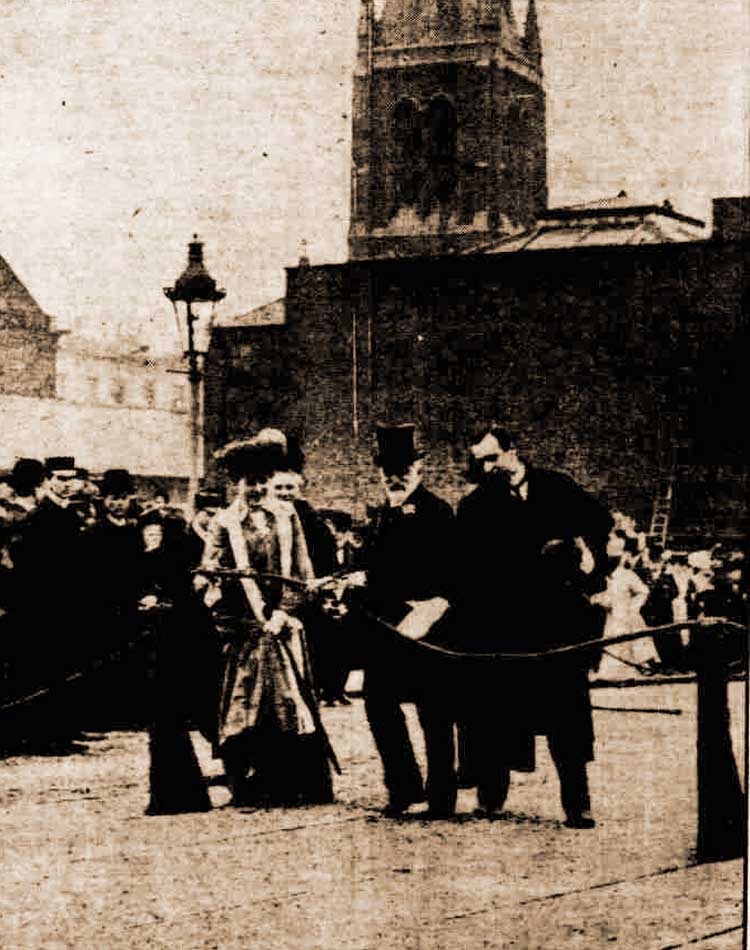
The Opening of the New Vauxhall Bridge.
From The London Daily News, Monday, 28th May, 1906
Copyright. The British Library Board.
One of the major aesthetic criticisms of the design for the new bridge was that it was, to say the least, rather plain and somewhat mundane.
It needed jazzing up!
In 1903, during the construction of the bridge, the London County Council had sought the opinion of the architect William Edward Riley (1852 - 1937) about possible adornments that might help make the bridge more visually appealing.
Riley had suggested the construction of two giant pylons, to be topped with statues on either side of the bridge. He also suggested that decorative sculptures should be added to the piers of the bridge.
The idea of the pylons was rejected on the grounds of cost, since the project was already way over budget.
However, following a further consultation with architect Richard Norman Shaw (1831 - 1912), the addition of a series of monumental bronze statues above the piers of the bridge was given the go ahead, and sculptors Alfred Drury (1856 - 1954) and Frederick Pomeroy (1856 - 1924) were commissioned to design these new adornments.
The statues had not been completed in time for the bridge's opening in 1906, but they were finished just over a year later, and preparations were made to put the giant figures - "strange watchers of the Thames", as the Penny Illustrated Paper dubbed them - in place on either side of the bridge.

The Statues In Position
From The Graphic, Saturday, 14th September, 1907
Copyright. Mary Evans Picture Library.
The herculean undertaking of lifting the colossal figures into place was undertaken over the course of September 4th and 5th, 1907, and, given the rudimentary means available to them, I have to say, you can't help but admire the workmen who accomplished the task.
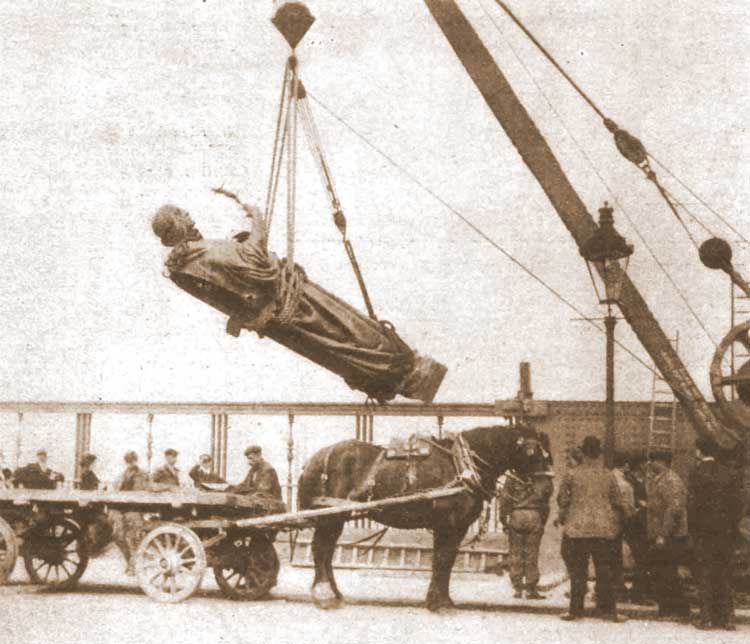
One of the Sculptures Being Lifted Into Place.
From The Penny Illustrated Paper, Saturday, 21st September, 1907
Copyright. The British Library Board.
The Pall Mall Gazette provided its readers with an account of the new sculptures in its edition of Wednesday, 4th September, 1907:-
"It is about eighteen months since Vauxhall Bridge was opened for traffic, and now the County Council have commenced to decorate the faces of the structure with magnificent bronze symbolical figures, in accordance with the original scheme.
Eight figures, much larger than life size, varying in weight from thirty-five to forty-three hundredweight, will be mounted in niches formed in the steel panels above the abutments of the bridge, four on the north and four on the south.
Three figures have already been mounted.
Ceres, symbolical of the first and foremost industries, given the place of honour on the side, near Grosvenor-road. The mythical goddess bears large sheaf of wheat in her right hand, and an ancient-looking scythe in her left hand.
Next in order, civil engineering, is symbolised, the figure having a pair of compasses in the right hand and a fine model of a technical college in the left; and the third represents mechanical engineering, with the primary tools of the profession.
The other figures will symbolise commerce, painting, sculpture, architecture, and music.
Passengers who travel up and down the river by steamboat will be able to command a fine perspective of this artistic and majestic effect."

A Sculpture Being Put Into Place
From The Illustrated London News, Saturday, 14th September, 1907
Copyright. Mary Evans Picture Library.
And, there those "strange watchers of the Thames" stand to this day, their gazes fixed on some distant horizon located up and down the river, depending on which side of the bridge a particular figure is situated.
They are rarely noticed by those who pass back and forth over Vauxhall bridge, and are hardly ever noticed by those who pass beneath the bridge on the barges and pleasure cruisers that glide up and down the River.
But, for those who take the trouble to make their acquaintances, a richly rewarding experience awaits.
And, if you take the trouble to peer over the parapet alongside the second panel along on the upriver side of the bridge, or the right side, if you're heading over the bridge from the direction of Pimlico or Victoria, you'll glimpse part of the sculpture that represents architecture.
She holds in her hand a perfectly scaled down miniature of St Paul's Cathedral, the masterpiece of Sir Christopher Wren; and, let's be honest, what better representation of architecture could there be?
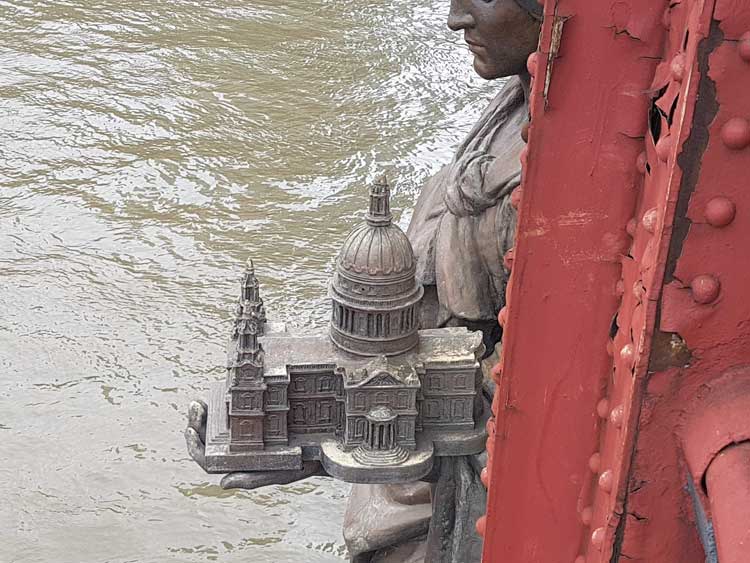
Architecture Holding St Paul's Cathedral.